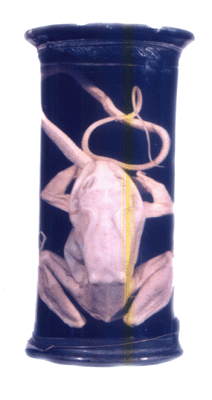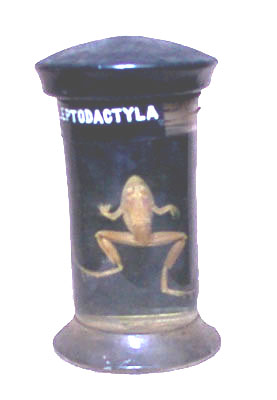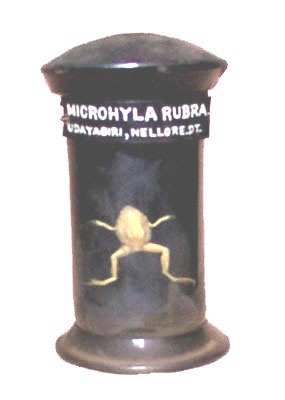 |

|
.
Rana Tigrina Swallowing a Snake
It is similar to the Rana hexadactyla. It has a
special character i.e., it swallows a snake. This unusual exhibit was netted from the museum
pond while in the act of swallowing a snake. |
| Rana leptodactyla
This is a species of rather small-sized
frogs, with somewhat thin and attenuated limbs. The head is more or less strongly depressed,
as long as broad or a little broader than long, with a rounded snout, slightly projecting
beyond the mouth. The fingers are moderately long, with their tips dilated into rather large
discs which are slightly broader than long, and bear a groove in front, separating the upper
from the lower surface. The first finger is shorter than the second. The sub-articular
tubercles on the fingers are moderately large. The hind limb is rather thin a long, with the
tibiotarsal articulation reaching the tip of the snout or even beyond. The toes are rather
long, depressed, dilated at the tips into large discs, and are only partially webbed. The
sub-articular tubercles on the toes are rather small and inconspicuous. There is no tarsal
fold and the inner metatarsal tubercle is elliptical.
|

|

|
Microphyla rubra
This genus includes frogs of rather small
size and slender build. The pupil is vertical and circular. The tongue is rather narrow and
elliptical, free behind and not notched. The palate is toothless, with a more or less distinct
dermal ridge across the palate and another similar ridge in front of the pharynx. The tympanum
is concealed. The fingers are free, but the toes are webbed to a greater or less extent,
sometimes very slightly. The tips of the digits are usually more or less dilated. The outer
metatarsals are united. The sternum is cartilaginous. The terminal phalanges are T-shaped. |
|
 |
|